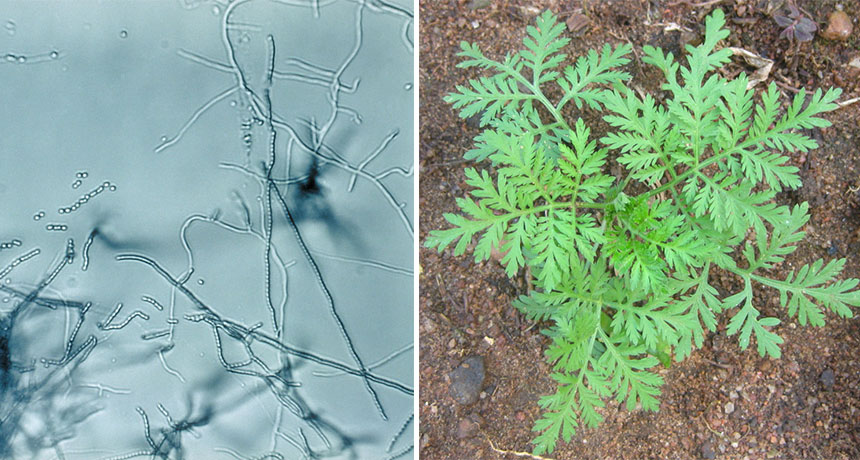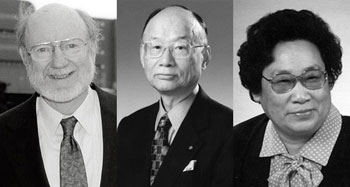Nobel goes for developing drugs from nature
A trio of winners found treatments for common human infections using chemicals made by bacteria and a plant

Medicines originally developed by this year’s Nobel winners are chemicals originally derived from these organisms: the Streptomyces bacteria (left) and sweet wormwood plant (right).
Left: CDC; right: tonrulkens/Flickr (CC BY-SA 2.0)
By Tina Hesman Saey and Laura Sanders
On October 5, the 2015 Nobel Prize in medicine or physiology was awarded to three scientists who developed drugs that have saved the lives of millions of people around the world. The winners will share prize money worth $958,000. Two worked on a drug to combat infections due to tiny insect-borne worms. The third discovered a drug to treat malaria.
Each medicine was based on chemicals made by Mother Nature.
“This is one of those Nobel Prizes for drugs that have truly impacted hundreds of millions of people, no exaggeration,” says Anthony Fauci. He directs the National Institute of Allergy and Infectious Diseases in Bethesda, Md.

One half of the award goes to William Campbell of Drew University in Madison, N.J., and Satoshi Ōmura of Kitasato University in Tokyo, Japan. They worked on a drug called ivermectin (EYE-ver-MEK-tun). It treats infections caused by roundworms, a type of parasite.
The other half of the Nobel goes to Youyou Tu of the China Academy of Chinese Medical Sciences in Beijing. She discovered artemisinin (AR-the-MISS-eh-nin), which is used against the parasite causing malaria. It’s spread by mosquitoes.
Together, ivermectin and artemisinin “have been more benefit to humankind than any other” drug, says Christopher Plowe. He’s an expert on parasites who works at the University of Maryland. He’s also president of the American Society for Tropical Medicine and Hygiene.
From a golf course
Ōmura discovered a bacterium called Streptomyces avermitilis (STREP-tow-My-sees AV-er-MY-till-is) near a golf course in Japan. This germ naturally makes avermectin. “Microorganisms are very important in nature, and … I learn from microorganisms,” Ōmura said in a telephone call with a representative of the Nobel committee.
Campbell is a biologist who had been focusing on parasites at the drug company Merck. He tested the compound and found that it was very good at killing the larvae of some parasites. Later, the compound was tweaked to make ivermectin. This drug is even more powerful against parasites that infect people and animals.
The drug was first used to treat diseases in animals caused by parasites. It is still used to prevent heartworm in dogs. It also can kill ear mites. In many parts of the world, the drug is used to treat farm animals such as cows, sheep and horses. Among such livestock, it stops infections caused by bloodsucking parasites.
In time, Campbell and other scientists learned ivermectin also could work against diseases in people. Two of the most serious of these: river blindness and elephantiasis (EL-eh-fan-TY-ah-sis). But the drug also works well against lice and a disease called scabies. Mites cause that disease.
Ivermectin has been the single biggest factor in eliminating river blindness from Latin America, says Ben Makepeace. He’s a parasite expert at the University of Liverpool in England. That disease is caused by a very tiny roundworm called Onchocerca volvulus. It’s transmitted by the bite of black flies. Microscopic, thread-like larvae of these worms are known as microfilariae (MY-kroh-fil-AAR-ee-ay). These larvae can move through the eyes and under the skin. As they do, they can trigger permanent blindness, severe itching and inflammation.
In 1987 Merck began giving away ivermectin for free. The goal was to help wipe out river blindness. And thanks to this drug, Colombia and Ecuador have now eradicated the disease. The drug kills only worm larvae. But the good news: People only need to take one dose each year to keep those larvae from growing, Makepeace says. “That’s how powerful [the drug] is.”
Ivermectin also treats infections with roundworms that cause elephantiasis. This disease affects some 120 million people. Adult forms of the worm live in the body’s lymph system. Infected mosquitoes spread the larvae as they bite people. Over time, the worms clog the lymph system. This can cause the victims limbs or other body parts to undergo a disfiguring swelling.
Ivermectin used together with a second drug can stop the spread of the worms. Merck also donates ivermectin to treat elephantiasis. Today, some 300 million people take the drug each year to treat for river blindness and elephantiasis.
Learning from ‘traditional’ medicine
The other half of the Nobel Prize recognizes a remedy for malaria. As of 2013, it afflicted nearly 200 million people. Artemisinin is part of a drug cocktail used to treat the infection. Of those medicines, artemisinin is the top choice to fight the malaria protozoan — Plasmodium falciparum (Plaas-MO-dee-um Fal-SIP-ah-rum). Indeed, says Fauci, artemisinin “is a critical drug in our fight against malaria.”
This modern drug has ancient roots. In 1967, China began Project 523. The government wanted to stamp out its big malaria problem.
For thousands of years people had used herbs to fight this disease. No one knew which herbal ingredients were most effective. So Tu and her colleagues combed through more than 2,000 traditional Chinese herbal recipes. And they found one chemical that showed promise. It came from the sweet wormwood plant (Artemisia annua). They used an extract of the chemical to treat malaria in mice and monkeys. And it worked. Tu then tested it on herself to make sure the drug also was safe for people.
She and colleagues figured out ways to get a pure form of the chemical. From that they prepared the drug. “She took this from herbal treatment to medicine,” explains Dyann Wirth. Working at the Harvard T.H. Chan School of Public Health, she studies how the immune system works and how germs cause infection. Speaking of Tu, Wirth says that “She’s clearly a brilliant woman. But to have the tenacity to accomplish this is truly amazing. I have enormous respect for her.”
Artemesinin is one of the most widely used drugs in the world, Wirth says. It often is used along with other medicines. The drug quickly rids the bloodstream of most Plasmodium parasites. A partner drug can then mop up the remaining malaria parasites.
Many more useful drugs are just waiting to be discovered in plants, soil and other natural sources, Campbell says. “Nature consistently produces molecules that have not been thought of by humans.”
Power Words
(for more about Power Words, click here)
bacterium (plural bacteria) A single-celled organism. These dwell nearly everywhere on Earth, from the bottom of the sea to inside animals.
debilitate (adj. debilitating) To make weak, sickly or feeble.
elephantiasis A parasitic infection spread by thread-like larvae of certain roundworms. It’s sometimes called lymphatic filariasis because the filament-like larvae move to the body’s lymph system where they can clog it up. The disease affects some 120 million people. The skin of affected people becomes thick and hard. A fluid buildup can cause a swelling in the legs, and sometimes in the arms, breasts and genitals. This disfiguring disease leads many victims to be shunned over the disfiguring disability it causes.
embryo The early stages of a developing vertebrate, or animal with a backbone, consisting only one or a or a few cells. As an adjective, the term would be embryonic — and could be used to refer to the early stages or life of anything from a germ to an electronic system or technology.
eradicate To get rid of; eliminate.
extract A substance, often in concentrated form, that has been removed from its natural source. Extracts are often taken from plants (such as spearmint or lavender), flowers and buds (such as roses and cloves), fruit (such as lemons and oranges) or seeds and nuts (such as almonds and pistachios). Such extracts, sometimes used in cooking, often have very strong scents or flavors.
genitals or genitalia The visible sex organs.
germ Any one-celled microorganism, such as a bacterium, fungal species or virus particle. Some germs cause disease. Others can promote the health of higher-order organisms, including birds and mammals. The health effects of most germs, however, remain unknown.
infection A disease that can spread from one organism to another.
inflammation The body’s response to cellular injury and obesity; it often involves swelling, redness, heat and pain. It is also an underlying feature responsible for the development and aggravation of many diseases, especially heart disease and diabetes.
larva (plural: larvae) An immature life stage of an insect, which often has a distinctly different form as an adult. (Sometimes used to describe such a stage in the development of fish, frogs and other animals
lymph (adj. lymphatic) A colorless fluid produced by lymph glands. This secretion, which contains white blood cells, bathes the tissues and eventually drains into the bloodstream.
malaria A disease caused by a parasite that invades the red blood cells. The parasite is transmitted by mosquitoes, largely in tropical and subtropical regions.
microbe Short for microorganism. A living thing that is too small to see with the unaided eye, including bacteria, some fungi and many other organisms such as amoebas. Most consist of a single cell.
microfilariae The larval form of some roundworms. They get their name for the fact that they look like little fibers or filaments. Those from the species Onchocerca volvulus are responsible for river blindness, also known as onchocerciasis.
molecule An electrically neutral group of atoms that represents the smallest possible amount of a chemical compound. Molecules can be made of single types of atoms or of different types. For example, the oxygen in the air is made of two oxygen atoms (O2), but water is made of two hydrogen atoms and one oxygen atom (H2O).
parasite An organism that gets benefits from another species, called a host, but doesn’t provide it any benefits. Classic examples of parasites include ticks, fleas and tapeworms.
physiology The branch of biology that deals with the everyday functions of living organisms and how their parts function. Scientists who work in this field are known as physiologists.
plasmodium A form within the life cycle of some simple organisms such as slime molds, typically consisting of a mass of naked protoplasm containing many nuclei. (in medicine) It also refers to a genus of protozoa that cause the disease malaria. The Plasmodium genus includes more than 100 species; just five are responsible for most infections in humans.
protozoan (plural: protozoa) Any of many types of single-celled organisms, most of them too small to be seen with the unaided eye. They include amoebas, parameciums and many others. Some can cause disease in humans and other animals.
river blindness A parasitic disease caused by infection with a worm known as Onchocerca volvulus. It’s spread through bites by a carrier insects: blackflies. These insects live near fast-flowing rivers. As as its name implies, the disease can leave its victims blind. It also can cause a serious skin disease and unstoppable itching. Most of its victims live in Africa, where at least 25 million people are infected. Of these, some 300,000 people are now blind and 800,000 more have impaired sight.
tenacity (adj; tenacious) To pursue something to completion or to hold onto something without letting go; never giving up.
traditional medicine A term for therapies and treatments that have evolved by trial and error and then been spread by word of mouth. Many of these are plant-based therapies that tribal peoples or old-style “healers” have learned from their elders. Scientists have sometimes found that these work. But with research, modern medicine often can develop a more potent version in the lab or one that does not require harvesting rare species.







